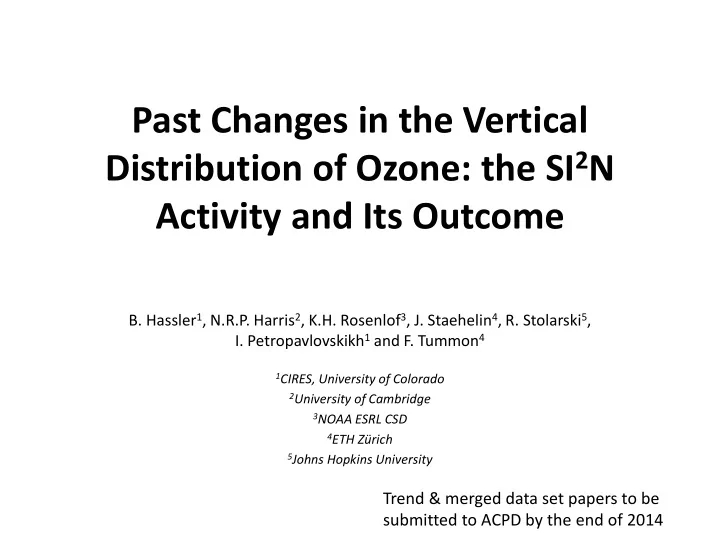

Past Changes in the Vertical Distribution of Ozone: the SI 2 N Activity and Its Outcome B. Hassler 1 , N.R.P. Harris 2 , K.H. Rosenlof 3 , J. Staehelin 4 , R. Stolarski 5 , I. Petropavlovskikh 1 and F. Tummon 4 1 CIRES, University of Colorado 2 University of Cambridge 3 NOAA ESRL CSD 4 ETH Zürich 5 Johns Hopkins University Trend & merged data set papers to be submitted to ACPD by the end of 2014
What is SI 2 N? • The joint SPARC/IO 3 C/IGAC-O 3 /NDACC Initiative on Past Trends in the Vertical Distribution of Ozone • Follow on activity to the SPARC/IOC/GAW Assessment of trends in the vertical distribution of ozone, 1998, ( which addressed the difficulties in deriving consistent global profile ozone trends in the lower stratosphere and disagreement between existing satellite time series )
SI 2 N • Activity started with a workshop in Geneva in Jan 2011…led by Neil Harris and Rich Stolarski. • It is culminating with publication of > 30 papers in a special issue of Atmospheric Chemistry and Physics (ACP), Atmospheric Measurement Techniques (AMT) and Earth System Science Data (EESD). The link for the complete issue is http://www.atmos-chem- phys.net/special_issue284.html • This presentation will address points from three of the special issue papers: a measurement overview (Hassler et al., 2014), a paper on merging data sets (Tummon et al, in prep) and a paper on ozone trends (Harris et al., in prep).
SI 2 N Key Goal: Provide measurements that can be used for detection and attribution of stratospheric ozone changes critical examination of the pattern and time sequence of ozone change Accurate knowledge of altitude, latitude, and seasonal structure of the ozone variability is required High quality measurements with well defined uncertainties
SI 2 N – working groups
Motivation: What were the conclusions of SPARC, 1998; what do we need to know now? Combined estimate of the mean trend in vertical distribution of ozone over northern mid-latitudes from 1980-1996 (heavy solid line) calculated using the trends derived from SAGE I/II, ozonesondes, SBUV and Umkehr measurements. Uncertainties are shown as 1 σ (light solid lines) and 2 σ (dashed lines).
Where are we now? mid latitude Equivalent Effective Stratospheric Chlorine, from P. Newman
Motivation: Where do we stand now? How does the ozone profile recover as ODS decrease? Recent measurements of the vertical ozone distribution did not say much at all about • ODS recovery • Effect of climate change Why? No consistent global view of ozone profile measurements after 2005 • SAGE (workhorse for 1984-2005) turned off; as was HALOE (1991-2005) • Many satellites making profile measurements since 2005, but they have not been well enough assessed to know what has been happening to trends in ozone profile Slide from Neil Harris
SI 2 N Approach 1) Compile and document all ozone profile data in a consistent manner/location See Hassler et al., 2014, AMTD (accepted in AMT) 2) Merge data sets where possible to extend periods for which trends can be assessed Paper in preparation: Fionna Tummon et al (for ACPD) 3) Analyze trends using both merged and individual instrument data sets. Paper in preparation: Neil Harris et al. (for ACPD) Note: there is also a measurement validation component, and the lead scientist is Jean-Christopher Lambert. This is not sufficiently mature to discuss here.
SI 2 N - Measurements Participated in SI 2 N Related publication in the special issue
Hassler et al., 2014 AMT paper; measurements overview 4 tables presented: 1a) Measurement techniques and altitude ranges 1b) Vertical resolution, native vertical grid and native units 1c) Temporal coverage, number of measurements and time of day 1d) Data version, URL, relevant references Lots of information given…currently on line at AMTD, it is accepted and will hopefully be on AMT soon.
SI 2 N - merged data sets (Tummon paper) • 7 altogether • 7 different ways of combining different measurements • Single measurement system: SBUV (2x) • Two measurement systems: SAGE II and OSIRIS, SAGE II and GOMOS (2x) • Multiple measurement systems: GOZCARDS, SWOOSH
Ozone Timeseries & anomalies & % differences, 20N-20S, 50hPa From Tummon et al.
Figure 4: Annual Cycle Figure 4 : Annual cycle, as described by the multiple linear regression model at (a) the NH upper stratosphere (3hPa/~40km), (b) EQ lower stratosphere (50hPa/~20km), and (c) SH middle stratosphere (10hPa/~30km).
Merging paper conclusions: Needed because we don’t have a long term continuous data set that is global Differences are smaller than seen on an instrument by instrument study (Tegtmeir et al. 2013) Differences have impacts on calculated trends…particularly where the trend is small .
Trends: estimated via regression • Piece-wise multiple linear regression • Two linear trends with an inflection point at the end of 1997 • Monthly means – not deseasonalized before used in the regression • Basis functions: Offset (annual cycle), 2x trend, 2x QBO (second QBO time series orthogonalized to first), solar cycle, ENSO, volcanic aerosol • Regression only calculated if at least 50% of input data are available Harris et al., in prep
SI 2 N - merged data sets: trends 1984-1997 1998-2011 (Tummon et al., 2014, in prep.) Latitude average of annual trends (in %/decade) for 1984-1997 (top row) and for 1998-2011 (bottom row), SH (left), EQ (middle), NH (right).
Do endpoints matter?
SI 2 N - merged data sets: lessons learned • Essential for determining trends as we go forward • Introduces a lot of uncertainties into trend analysis (more work is needed to merge better) • Should be a point of consideration for planning future observational systems • Ground-based measurement systems absolutely necessary to validate the merged data sets • Overall, stratospheric decreases during the early period have shifted to either smaller negative values or to increases. Next step should be comparisons to model predictions for the same time periods.
Thanks for listening!
Recommend
More recommend